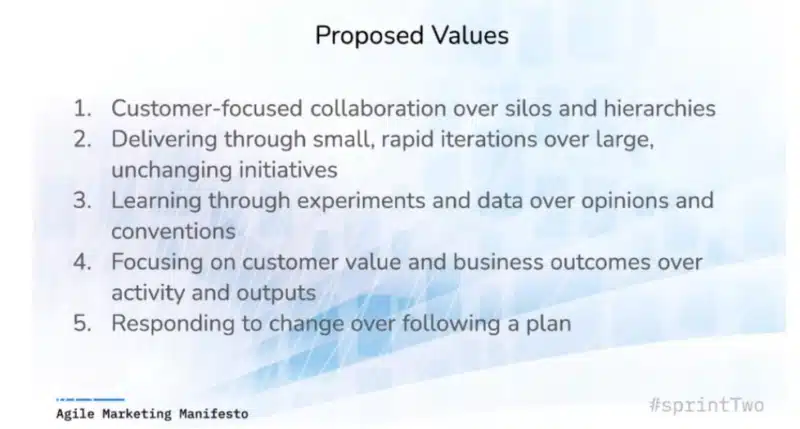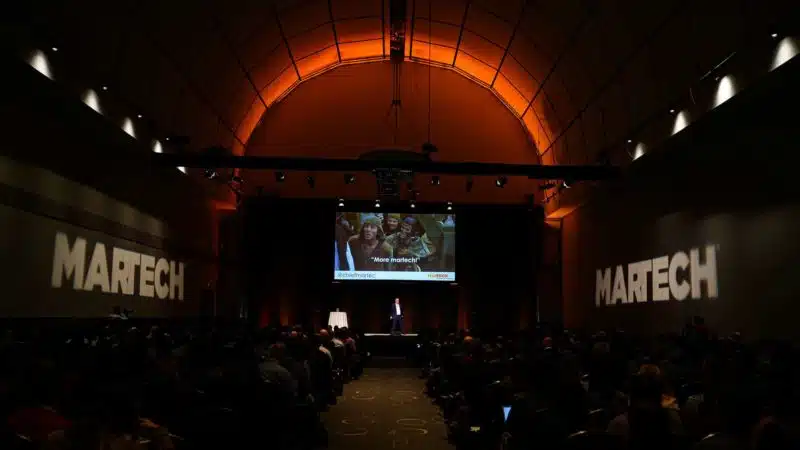How agile is transforming modern marketing
Learn why agile is becoming the new foundation for marketing going forward.
Kim Davis, editorial director of MarTech, discussed updates to the Agile Marketing Manifesto with industry leaders at our MarTech conference. Many of these changes stemmed from developments at a recent virtual gathering of over 80 agile marketers from around the world.
John Cass, co-founder of AIContentGen, spoke of the gathering — the SprintTwo conference — that made some much-needed improvements to the Manifesto: ”The first conference took place in 2012 — at that one, we developed the Manifesto because we felt that the practices of agile were needed by marketers at this point in time.”
The marketers at SprintTwo were asked what they believed were the core values of agile marketing. Based on their responses, it appears agile has the potential to shape the future of marketing as a whole.

Note: Subsequent to the session, the values were finalized.
The importance of agile marketing values
The proposed agile marketing values say much about where the industry is headed. They outlined where top professionals in the field see agile methodologies shaping how consumers and brands interact.
“These values are the basis of it all,” said Giannina Rachetta, marketing manager at 3M. “Marketers need to shift their mindsets — to let go of the old ways of how we used to do marketing and do what our colleagues in the product development side have successfully adopted.”
But not everyone has the same ideas when it comes to the path forward. It all depends on which side of marketing you’re operating in.
“People look at it from their point of view from their world,” said Stacey Ackerman, owner of Agilify Coaching & Training. “If they’re working in a company, they’re looking at it from how that language may be interpreted in their organization, and often what I see is where it could get misused.”
She added, “But we landed in a good place. We had a good consensus from most people that these are meaningful values to have in our community.”

Understanding customer-centricity
One of the biggest issues agile marketers — and marketers in general — face is how best to address the customer. Most marketing professionals agree customers should be the focus of any campaign, but few know how to best define “customer-centricity” accurately.
“So the marketing language is one thing,” said Cass, “but the other is the issues that people face today. With so much digital transformation going on, we have to think about the customer journey.”
Building relationships is a key ingredient of any marketing campaign’s success — even more so with agile methodologies. Their ability to adapt to changing consumer patterns makes them a foundational piece of relationship marketing. But, at its core, agile should serve the purposes of customer relationships — whether through conversations or tailored messages.
“Meaningful conversations are going to be interpreted differently depending on your organization,” said Ackerman. “I think about actually talking to each other versus relying on a tool; that is one of the issues I see in a lot of companies. They don’t take the time to converse with each other.”
Read next: A set of 10 principles were drawn up to reflect the finalized values
A transformed agile marketing ecosystem
“Having an advanced [Agile marketing] ecosystem means that it can have better tools to help you do your job better,” Rachetta said. “Having more thought leadership can bring in that learning and spread it around.”
Marketing systems can thrive when they’re installed in adaptive frameworks, or “ecosystems,” and marketers are finding tools based on agile methodologies to be quite effective. Some professionals believe these tools and methods are so prevalent that they’ve already brought us into the next level of agile marketing.
“So many people are experimenting and trying agile marketing and they’re seeing what’s working and not working for them in the real world,” said Ackerman. “That’s exciting to see as it becomes more mainstream.”
But, convincing your whole team to transform their marketing operations can prove difficult. There’s always concern about poor results when adopting new frameworks. That’s why agile practitioners need to highlight the success of these methods in other departments.
“Developers have always had a method about how they work,” said Cass. “Whereas marketers might have strategies and ways of doing marketing, we don’t have processes on how you do marketing. That’s a different question.”
“I think that what agile offers are an opportunity for a way of working and also addressing some of those big issues in the marketing profession,” he added.
Watch the full presentation from our MarTech conference here (free registration required).
Opinions expressed in this article are those of the guest author and not necessarily MarTech. Staff authors are listed here.
Related stories